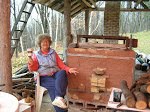I am still working on this. It took me many years to "see" what was wrong with my "pulled first and then attached handle". Three years later I am still working to perfect this type of handle. I suspect that it will always be a work in progress.
One thing that I find is that if you do not time the stiffness of the mug correctly you can easily distort the cup when pulling the handle which may distort again in the firing due to clay memory. This would always discourage me trying to make this type of handle.
In order to be able to attach a handle without distorting the cup when I was learning this type of handle I would keep a variety of fast food cups on hand and stick them into the cup until they fit snugly and make a good seal. For the initial attachment I would put my left hand inside to support the wall of the cup. But once I started pulling the handle I placed a correctly sized fast food cup inside the rim until it fitted tightly. That way - no distortion when applying and working on the handle and less chance of clay memory distorting the cup in the firing. I have a variety of different sized cups on hand for this. Also as a final touch I rotated a tightly fitting cup inside the clay cup to "set" the roundness of the rim.
Many tips also mention tapping the end of the handle to compress the butt end. You can do this with your forefinger, or tapping on the table or use a wooden paddle. For a long time I just did not see the reasoning behind this until it finally hit me (duh!!). The more compressed the clay, the smaller the distances between the particles and so the less they will shrink when drying - so this prevents cracks from developing at the joint.
 |
| Tapping to compress the end of the handle prior to attachment |
 |
| Pulled handle pugs prior to compressing on left and after compressing on right - note its oval shape and smooth edges of the butt end. |
 |
| Rather fuzzy pic - but it shows the scoring that leaves an unscored edge all round the butt end. |
I never score the bottom join and never compress it either and never seem to have problems on the bottom join. I always cover the cups overnight and after that air dry them. - even speed stuff up after that in the oven or kiln with no cracking.
 |
| Three cups with the pulled handle |
So after three years I find that I have finally managed to put on handles with this method just as easily and fast as those that are pulled first but they look so much better - they seem to grow more out of the cup. However looking at the above three pics I think that they still need work - they seem to stick out a bit too much. It is hard to make them comfortable for two fingers yet look stylish.
Right now I seem to have gotten into a rut in the shape and style of pulled handle off the mug. My next goal is to work on the blended handle - where the join either top or bottom or both are fully blended into the cup. I really love those, but they are more time consuming to make, though well worth the effort.












